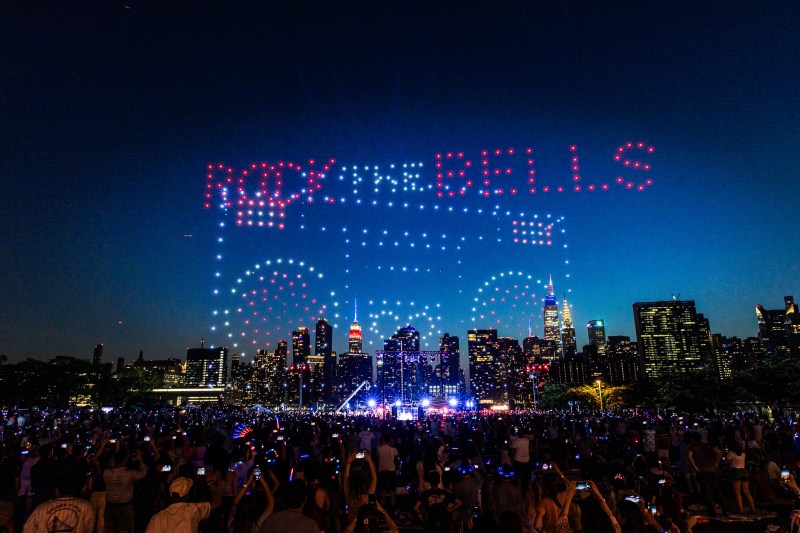In a bold move to fortify the rapidly expanding drone show industry, Verge Aero and ASTM International have announced the formation of a new task group to create formal drone show safety standards.
And now, they’re inviting the broader drone industry to join it. The action of building drone show safety standards comes in the wake of some drone show accidents. Most notably for the U.S., there was a chaotic crash during a drone show in Orlando in December 2024. During a public show in downtown Orlando, multiple drones tumbled from the sky mid-performance and left a child with severe injuries necessitating heart surgery.
This call for creating drone show safety standards comes at a pivotal moment for drone light shows, which have gone from niche novelty to center-stage spectacles at music festivals, theme parks, fireworks alternatives and even presidential celebrations.
But many people (including established drone show companies) have concerns around safety, especially as new players come to market. And as it becomes increasingly affordable and easy to create your own drone show company with ready-to-fly light show drones and easy-to-use software, some in the industry fear that might open the door for market players that either lack adequate experience or cut corners to stay competitive.
The Orlando crash wasn’t the first and won’t be the last if proper safety mechanisms aren’t prioritized. At The Drone Girl, we’ve covered the surge in drone shows with enthusiasm. Longtime readers know I went three nights in a row to see the Disneyland Paris Drone Show, because I’m that big of a fan.
And sure, drone shows are generally safer than fireworks. In fact, the U.S. Consumer Product Safety Commission (CPSC) received reports of eight deaths and an estimated 9,700 injuries involving fireworks in 2023. But just because drones aren’t as dangerous as fireworks doesn’t mean that safety can be overlooked.
The ASTM task group looking to create drone show safety standards
In response to worries about the safety of drone shows, ASTM International, a globally recognized standards organization, is convening a task group specifically to address drone show operations.
That task group will create technical guidelines covering everything from system redundancies to operational best practices.
Nils Thorjussen, executive chairman of Verge Aero, which is a drone show company based in Texas but that puts on shows nationwide, will chair the group. And in fact, Verge Aero makes its own, ridiculously easy-to-use drone show software.
According to Thorjussen, the group also has backing by the Federal Aviation Administration.
How to join the ASTM task group
The formation of ASTM’s drone show task group is an open invitation. Companies, pilots, manufacturers and even event organizers are urged to participate. Verge Aero is spearheading the charge, offering their white paper freely at verge.aero/safety and encouraging interested parties to reach out via email at standards@vergeaero.com.
The five pillars of drone show safety

To kickstart the industry conversation, Verge Aero released a comprehensive white paper titled The Essential Guide to Drone Show Safety. In it, they outline five key elements required for safe and professional drone light shows (while also promoting their own safety systems):
- Navigation redundancy: Verge Aero emphasizes that one estimator is not enough. Their X1 and X7 drones feature multiple redundant navigation systems. Those systems use as many as six estimators to protect against sensor failure and data inaccuracy, which are common culprits in drone flyaways.
- Appropriate and up-to-date software: Outdated autopilot software leaves drones vulnerable. Verge Aero’s system uses the latest PX4 software (v1.15+), which is designed to take full advantage of estimator redundancy and flight deconfliction. The platform’s show-building software also mathematically validates flight paths to avoid midair collisions.
- Multiple and independent geofence systems: Verge’s geofencing technology includes soft “dynamic bubble” geofences for each drone, traditional hard geofences, and predictive trajectory geofences. These layers work together to ensure drones land safely before breaching any dangerous airspace.
- Reliable, long-range communication: Verge Aero avoids WiFi (notoriously unreliable in high-interference environments) in favor of long-range point-to-point communication links that maintain full control of the fleet during emergencies—even kilometers away from the operator.
- Training and safety management: Borrowing from commercial aviation, Verge’s approach includes ongoing pilot training, a formal Safety Management System, and an emphasis on rest and clear-headed decision-making. “Pilots don’t just press play,” the company stresses. “They must remain alert, engaged, and ready to act.”
The post Drone show leaders unite to develop drone show safety standards appeared first on The Drone Girl.
